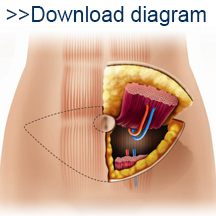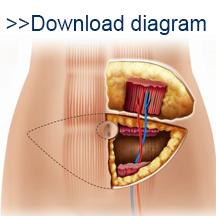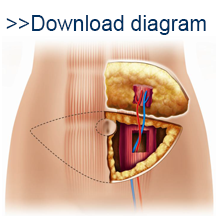Once you have decided that breast reconstruction is right for you, you will need to discuss your personal goals and preferences with your surgeon to identify which surgical option would be most successful for your body type and personal goals. Flap reconstruction options use your existent tissue, taken from a different area of your body, to recreate the breast. One common flap procedure is known as TRAM, or traverse rectus abdominal muscle, flap reconstruction. To complete this operation, surgeons use tissue from your lower abdomen to create a new breast.
How is this TRAM flap reconstruction done?
In the TRAM procedure, the skin, fat, and muscle of the lower abdomen are used to recreate the breast. This is some of the same tissue that is taken during a "tummy tuck" procedure. Tissue from the abdomen used in TRAM flap reconstruction can be taken in two different ways: using a tunneling, “pedicle,” TRAM flap or using a free, “microsurgical,” TRAM flap. Pedicle TRAM flap
In the pedicle ("tunneling") method of this procedure, this tissue is separated from its original location (without being completely disconnected), turned upwards, and tunneled under the abdomen. It is brought up and out through the mastectomy site (or scar depending on time of reconstruction). The tissue is then sculpted to look as much like the other breast as possible. The lower abdomen site is then sewn back together. In case of a double mastectomy, the tissue on the lower abdomen may be used to make two breasts. Free TRAM flap
The "free flap" (microsurgical) TRAM commonly uses the same tissue as the "tunneling" method described above. The main difference in the free TRAM reconstruction is that the tissue, rather than remaining attached, is completely removed from the body. Following its removal from the abdomen, the tissue is transferred to the mastectomy site. This requires that the artery and vein which supply blood to the flap tissue to be moved as well. When the tissue is brought up to the mastectomy site, the flap is connected to the circulation of the breast.
Outcomes and Recovery
Some surgeons prefer the "free flap" method to the "tunneling" method because they may be better able to sculpt the tissue to the shape of a normal breast (and thus to match the other breast). Using a natural tissue, instead of an implant, allows for the newly constructed breast to change alongside the natural breast, like in weight changes. The main concern about the free TRAM procedure is that the reconstruction depends upon the newly attached blood vessels to the flap tissue. If these fail, then there can be "flap death," and the new breast will be lost. This is a similar risk taken during DIEP flap. Unlike in DIEP flap, TRAM flap procedures can potentially have a negative effect the muscle wall in the abdomen because a section of the muscle is taken away.
After surgery, you will remain under close observation for three to five days. This allows the surgical team to closely monitor blood flow to the newly constructed breast, ensuring that the flap is healthy. Drains placed in the breast and donor area of the abdomen stay in place for two to three weeks while the patient recovers at home, and are taken out during an office visit. Within six weeks, patients may return to driving, some work (depending on job requirements) and light exercise. Most patients are back to their regular routines and full activities in eight weeks. Because TRAM flap takes a section of the muscle wall, you will not be able to lift heavy weights during recovery.
Is TRAM flap right for me ?
The TRAM flap procedure is the right fit for some patients, but it is important that your choice takes into consideration your body type, health, lifestyle, and personal reconstruction goals. You will want to explore all reconstruction options, before making a decision. We suggest scheduling a consultation with one of our experts in breast reconstruction. The surgeon will be able to identify donor sites that will work for your body. During the visit, you will have a chance to ask questions, choose a surgical plan, and discuss preparation and recovery. Your surgeons and care team The plastic surgeons and care team members who perform breast reconstructions and help patients recover from the procedure are experts in their field. All surgeons including the plastic surgeons and surgical oncologists work very closely to plan your surgical treatment and reconstruction. All of our surgeons are board-certified in plastic surgery and have years of experience in breast reconstruction procedures. Learn more about the team through the profiles below.
Make an Appointment
If you are ready for a consultation about breast reconstruction, call 734-998-6022 to schedule an appointment with one of our specialty plastic surgeons.




